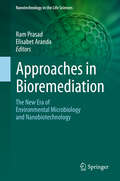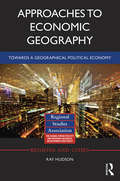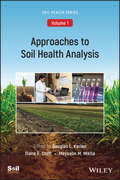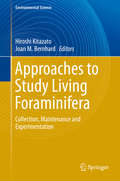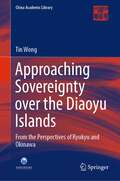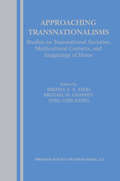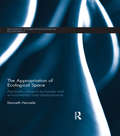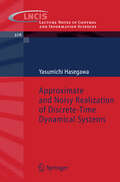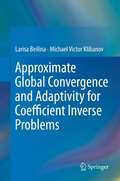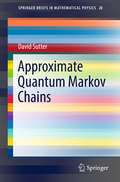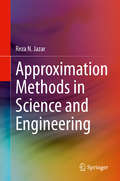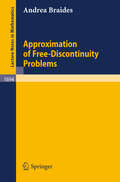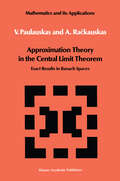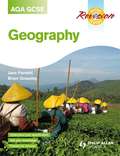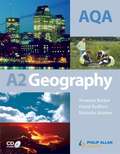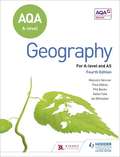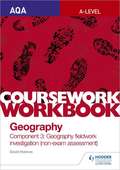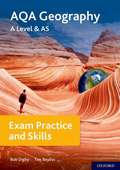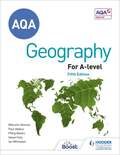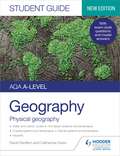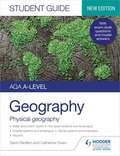- Table View
- List View
Approaches in Bioremediation: The New Era of Environmental Microbiology and Nanobiotechnology (Nanotechnology in the Life Sciences)
by Ram Prasad Elisabet ArandaBioremediation refers to the clean‐up of pollution in soil, groundwater, surface water, and air using typically microbiological processes. It uses naturally occurring bacteria and fungi or plants to degrade, transform or detoxify hazardous substances to human health or the environment.For bioremediation to be effective, microorganisms must enzymatically attack the pollutants and convert them to harmless products. As bioremediation can be effective only where environmental conditions permit microbial growth and action, its application often involves the management of ecological factors to allow microbial growth and degradation to continue at a faster rate. Like other technologies, bioremediation has its limitations. Some contaminants, such as chlorinated organic or high aromatic hydrocarbons, are resistant to microbial attack. They are degraded either gradually or not at all, hence, it is not easy to envisage the rates of clean-up for bioremediation implementation.Bioremediation represents a field of great expansion due to the important development of new technologies. Among them, several decades on metagenomics expansion has led to the detection of autochthonous microbiota that plays a key role during transformation. Transcriptomic guides us to know the expression of key genes and proteomics allow the characterization of proteins that conduct specific reactions. In this book we show specific technologies applied in bioremediation of main interest for research in the field, with special attention on fungi, which have been poorly studied microorganisms. Finally, new approaches in the field, such as CRISPR-CAS9, are also discussed. Lastly, it introduces management strategies, such as bioremediation application for managing affected environment and bioremediation approaches. Examples of successful bioremediation applications are illustrated in radionuclide entrapment and retardation, soil stabilization and remediation of polycyclic aromatic hydrocarbons, phenols, plastics or fluorinated compounds. Other emerging bioremediation methods include electro bioremediation, microbe-availed phytoremediation, genetic recombinant technologies in enhancing plants in accumulation of inorganic metals, and metalloids as well as degradation of organic pollutants, protein-metabolic engineering to increase bioremediation efficiency, including nanotechnology applications are also discussed.
Approaches to Economic Geography: Towards a geographical political economy (Regions and Cities)
by Ray HudsonThe last four decades have seen major changes in the global economy, with the collapse of communism and the spread of capitalism into parts of the world from which it had previously been excluded. Beginning with a grounding in Marxian political economy, this book explores a range of new ideas as to what economic geography can offer as it intersects with public policy and planning in the new globalised economy. Approaches to Economic Geography draws together the formidable work of Ray Hudson into an authoritative collection, offering a unique approach to the understanding of the changing geographies of the global economy. With chapters covering subjects ranging from uneven development to social economy, this volume explores how a range of perspectives, including evolutionary and institutional approaches, can further elucidate how such economies and their geographies are reproduced. Subsequent chapters argue that greater attention must be given to the relationships between the economy and nature, and that more consideration needs to be given to the growing significance of illegal activities in the economy. The book will be of interest to students studying economic geography as well as researchers and policy makers that recognise the importance of the relationships between economy and geography as we move towards a sustainable future economy and society.
Approaches to Economic Geography: Towards a geographical political economy (Regions and Cities)
by Ray HudsonThe last four decades have seen major changes in the global economy, with the collapse of communism and the spread of capitalism into parts of the world from which it had previously been excluded. Beginning with a grounding in Marxian political economy, this book explores a range of new ideas as to what economic geography can offer as it intersects with public policy and planning in the new globalised economy. Approaches to Economic Geography draws together the formidable work of Ray Hudson into an authoritative collection, offering a unique approach to the understanding of the changing geographies of the global economy. With chapters covering subjects ranging from uneven development to social economy, this volume explores how a range of perspectives, including evolutionary and institutional approaches, can further elucidate how such economies and their geographies are reproduced. Subsequent chapters argue that greater attention must be given to the relationships between the economy and nature, and that more consideration needs to be given to the growing significance of illegal activities in the economy. The book will be of interest to students studying economic geography as well as researchers and policy makers that recognise the importance of the relationships between economy and geography as we move towards a sustainable future economy and society.
Approaches to Soil Health Analysis, Volume 1 (ASA, CSSA, and SSSA Books)
by Douglas L. Karlen Diane E. Stott Maysoon M. MikhaApproaches to Soil Health Analysis A concise survey of soil health analysis and its various techniques and applications The maintenance of healthy soil resources provides the foundation for an array of global efforts and initiatives that affect humanity. Whether they are working to combat food shortages, conserve our ecosystems, or mitigate the impact of climate change, researchers and agriculturalists the world over must be able to correctly examine and understand the complex nature of this essential, fragile resource. These new volumes have been designed to meet this need, addressing the many dimensions of soil health analysis in chapters that are concise, accessible and applicable to the tasks at hand. Soil Health, Volume One: Approaches to Soil Health Analysis provides a well-rounded overview of the various methods and strategies available to analysists, and covers topics including: The history of soil health and its studyChallenges and opportunities facing analysistsMeta-data and its assessmentApplications to forestry and urban land reclamationFuture soil health monitoring and evaluation approaches Offering a far-reaching survey of this increasingly interdisciplinary field, this volume will be of great interest to all those working in agriculture, private sector businesses, non-governmental organizations (NGOs), academic-, state-, and federal-research projects, as well as state and federal soil conservation, water quality and other environmental programs.
Approaches to Soil Health Analysis, Volume 1 (ASA, CSSA, and SSSA Books)
by Douglas L. Karlen Diane E. Stott Maysoon M. MikhaApproaches to Soil Health Analysis A concise survey of soil health analysis and its various techniques and applications The maintenance of healthy soil resources provides the foundation for an array of global efforts and initiatives that affect humanity. Whether they are working to combat food shortages, conserve our ecosystems, or mitigate the impact of climate change, researchers and agriculturalists the world over must be able to correctly examine and understand the complex nature of this essential, fragile resource. These new volumes have been designed to meet this need, addressing the many dimensions of soil health analysis in chapters that are concise, accessible and applicable to the tasks at hand. Soil Health, Volume One: Approaches to Soil Health Analysis provides a well-rounded overview of the various methods and strategies available to analysists, and covers topics including: The history of soil health and its studyChallenges and opportunities facing analysistsMeta-data and its assessmentApplications to forestry and urban land reclamationFuture soil health monitoring and evaluation approaches Offering a far-reaching survey of this increasingly interdisciplinary field, this volume will be of great interest to all those working in agriculture, private sector businesses, non-governmental organizations (NGOs), academic-, state-, and federal-research projects, as well as state and federal soil conservation, water quality and other environmental programs.
Approaches to Study Living Foraminifera: Collection, Maintenance and Experimentation (Environmental Science and Engineering)
by Hiroshi Kitazato Joan M. BernhardForaminiferal cultures now serve as tools for researching biological, environmental, and geological topics. However, the biological backgrounds, in particular the natural histories of foraminifera, largely remain unclear. It is also true that the different techniques used in different subdisciplines are a setback to fully understanding the subject. Taken together, these factors prevent progress in experimental approaches to foraminiferal studies. This book aims to share and exchange knowledge between researchers from different subdisciplines, and the book should interest not only foraminiferal researchers but also scientists who are working with marine organisms to explore questions in relation to biology, geology, and oceanography.
Approaching Sovereignty over the Diaoyu Islands: From the Perspectives of Ryukyu and Okinawa (China Academic Library)
by Tin WongThis book discusses the sovereignty over the Diaoyu Islands from the perspectives of Ryukyu and Okinawa. Written in chronological order, the book has 13 chapters featuring 121 documents and maps. The first 12 chapters explain, based on detailed historical facts on the Diaoyu Islands, the rise and decline of the Ryukyu Kingdom and the historical roles of China, Japan, and the United States in the history of the kingdom. The final chapter is an overview of the Sino-Ryukyuan, Japan-Ryukyuan and US-Ryukyuan relations, and further clarifies the issue of ownership of the Diaoyu Islands and their strategic position. The book demonstrates that Ryukyu did not have sovereignty over the Diaoyu Islands, refutes Japan’s claim that these islands were a part of the Ryukyu Kingdom, and reveals the causes and consequences of the Sino-Japanese conflicts created by the United States. The book examines the 500-year friendship between China and Ryukyu, recounting moving stories. Lastly, citing ancient documents and more, the books proves that the Ryukyus never owned the Diaoyu Islands and that these islands belong to China.
Approaching Transnationalisms: Studies on Transnational Societies, Multicultural Contacts, and Imaginings of Home
by Brenda S. A. Yeoh Michael W. CharneyThe term 'transnationalism' has gained considerable academic and popular currency despite a lack of clear definitions, in part because its overall form changes as its influence incorporates additional spheres of daily life on a variety of scales and contexts. The purpose of this volume is to bring together different perspectives on this phenomenon, using case studies that represent some of the most current thinking on 'transnationalism' in a wide range of disciplines. Central themes which this book explores include legal and economic reactions to transnational migration; the (re)negotiation of identities in the context of changing national, social and cultural identities; and the emergence of new imaginings of home and social space in transnational communities. Approaching Transnationalisms: Studies on Transnational Societies, Multicultural Contacts and Imaginings of Home foregrounds powerful transnational forces crossing the boundaries of nation-states, and at the same time, gives attention to the continued significance of the nation-state and the diversity of localized reactions to transnational challenges.
The Appropriation of Ecological Space: Agrofuels, unequal exchange and environmental load displacements (Routledge Studies in Ecological Economics)
by Kenneth HermeleAlthough it is recognised that Thomas Robert Malthus was wrong when he posited a contradiction between population increase and agricultural growth, there are increasing signs that he could be proved right in the future. Perhaps Malthus was too late and too early in his prediction? He was too late, because he did not foresee the shift from land-based resources to fossil fuels, outing an end to the limits of agricultural growth, at least temporarily; and he was too early to witness that fossil fuels would come up against their own limits in terms of supply as well as in terms of global warming. This study deals with land-based resources and the role they play in the global socio-ecological metabolic regime, both now and in the future. In particular, the controversial use of agrofuels as a solution to coming scarcity is subjected to close scrutiny.
The Appropriation of Ecological Space: Agrofuels, unequal exchange and environmental load displacements (Routledge Studies in Ecological Economics)
by Kenneth HermeleAlthough it is recognised that Thomas Robert Malthus was wrong when he posited a contradiction between population increase and agricultural growth, there are increasing signs that he could be proved right in the future. Perhaps Malthus was too late and too early in his prediction? He was too late, because he did not foresee the shift from land-based resources to fossil fuels, outing an end to the limits of agricultural growth, at least temporarily; and he was too early to witness that fossil fuels would come up against their own limits in terms of supply as well as in terms of global warming. This study deals with land-based resources and the role they play in the global socio-ecological metabolic regime, both now and in the future. In particular, the controversial use of agrofuels as a solution to coming scarcity is subjected to close scrutiny.
Approximate and Noisy Realization of Discrete-Time Dynamical Systems (Lecture Notes in Control and Information Sciences #Vol. 376)
by Yasumichi HasegawaThis monograph deals with approximation and noise cancellation of dynamical systems which include linear and nonlinear input/output relations. It will be of special interest to researchers, engineers and graduate students who have specialized in ?ltering theory and system theory. From noisy or noiseless data, reductionwillbemade.Anewmethodwhichreducesnoiseormodelsinformation will be proposed. Using this method will allow model description to be treated as noise reduction or model reduction. As proof of the e?cacy, this monograph provides new results and their extensions which can also be applied to nonlinear dynamical systems. To present the e?ectiveness of our method, many actual examples of noise and model information reduction will also be provided. Using the analysis of state space approach, the model reduction problem may have become a major theme of technology after 1966 for emphasizing e?ciency in the ?elds of control, economy, numerical analysis, and others. Noise reduction problems in the analysis of noisy dynamical systems may havebecomeamajorthemeoftechnologyafter1974foremphasizinge?ciencyin control.However,thesubjectsoftheseresearcheshavebeenmainlyconcentrated in linear systems. In common model reduction of linear systems in use today, a singular value decompositionofaHankelmatrixisusedto?ndareducedordermodel.However, the existence of the conditions of the reduced order model are derived without evaluationoftheresultantmodel.Inthecommontypicalnoisereductionoflinear systems in use today, the order and parameters of the systems are determined by minimizing information criterion. Approximate and noisy realization problems for input/output relations can be roughly stated as follows: A. The approximate realization problem. For any input/output map, ?nd one mathematical model such that it is similar totheinput/outputmapandhasalowerdimensionthanthegivenminimalstate spaceofadynamicalsystemwhichhasthesamebehaviortotheinput/outputmap. B. The noisy realization problem.
Approximate Global Convergence and Adaptivity for Coefficient Inverse Problems
by Larisa Beilina Michael Victor KlibanovApproximate Global Convergence and Adaptivity for Coefficient Inverse Problems is the first book in which two new concepts of numerical solutions of multidimensional Coefficient Inverse Problems (CIPs) for a hyperbolic Partial Differential Equation (PDE) are presented: Approximate Global Convergence and the Adaptive Finite Element Method (adaptivity for brevity). Two central questions for CIPs are addressed: How to obtain a good approximations for the exact solution without any knowledge of a small neighborhood of this solution, and how to refine it given the approximation. The book also combines analytical convergence results with recipes for various numerical implementations of developed algorithms. The developed technique is applied to two types of blind experimental data, which are collected both in a laboratory and in the field. The result for the blind backscattering experimental data collected in the field addresses a real world problem of imaging of shallow explosives.
Approximate Quantum Markov Chains (SpringerBriefs in Mathematical Physics #28)
by David SutterThis book is an introduction to quantum Markov chains and explains how this concept is connected to the question of how well a lost quantum mechanical system can be recovered from a correlated subsystem. To achieve this goal, we strengthen the data-processing inequality such that it reveals a statement about the reconstruction of lost information. The main difficulty in order to understand the behavior of quantum Markov chains arises from the fact that quantum mechanical operators do not commute in general. As a result we start by explaining two techniques of how to deal with non-commuting matrices: the spectral pinching method and complex interpolation theory. Once the reader is familiar with these techniques a novel inequality is presented that extends the celebrated Golden-Thompson inequality to arbitrarily many matrices. This inequality is the key ingredient in understanding approximate quantum Markov chains and it answers a question from matrix analysis that was open since 1973, i.e., if Lieb's triple matrix inequality can be extended to more than three matrices. Finally, we carefully discuss the properties of approximate quantum Markov chains and their implications.The book is aimed to graduate students who want to learn about approximate quantum Markov chains as well as more experienced scientists who want to enter this field. Mathematical majority is necessary, but no prior knowledge of quantum mechanics is required.
Approximation Methods in Science and Engineering
by Reza N. JazarApproximation Methods in Engineering and Science covers fundamental and advanced topics in three areas: Dimensional Analysis, Continued Fractions, and Stability Analysis of the Mathieu Differential Equation. Throughout the book, a strong emphasis is given to concepts and methods used in everyday calculations. Dimensional analysis is a crucial need for every engineer and scientist to be able to do experiments on scaled models and use the results in real world applications. Knowing that most nonlinear equations have no analytic solution, the power series solution is assumed to be the first approach to derive an approximate solution. However, this book will show the advantages of continued fractions and provides a systematic method to develop better approximate solutions in continued fractions. It also shows the importance of determining stability chart of the Mathieu equation and reviews and compares several approximate methods for that. The book provides the energy-rate method to study the stability of parametric differential equations that generates much better approximate solutions.
Approximation of Free-Discontinuity Problems (Lecture Notes in Mathematics #1694)
by Andrea BraidesFunctionals involving both volume and surface energies have a number of applications ranging from Computer Vision to Fracture Mechanics. In order to tackle numerical and dynamical problems linked to such functionals many approximations by functionals defined on smooth functions have been proposed (using high-order singular perturbations, finite-difference or non-local energies, etc.) The purpose of this book is to present a global approach to these approximations using the theory of gamma-convergence and of special functions of bounded variation. The book is directed to PhD students and researchers in calculus of variations, interested in approximation problems with possible applications.
Approximation Theory in the Central Limit Theorem: Exact Results in Banach Spaces (Mathematics and its Applications #32)
by V. Paulauskas A. RackauskasAQA, A: Revision Guide (PDF)
by Brian Greasley Jane FerrettiSpecifically written for students following the AQA GCSE Geography Specification A course. Table of Contents: Unit 1: Physical Geography Section A: The restless earth; Rocks, resources and scenery; Challenge of weather and climate; Living world Section B Water on the land; Ice on the land; The coastal zone Unit 2: Human Geography Section A: Population change; Changing urban environments; Changing rural environments Section B: The development gap; Globalisation; Tourism
AQA, A2: Geography (PDF)
by Amanda Barker David Redfern Malcolm SkinnerComprehensive coverage for AQA A2 Geography students. Written by senior examiners and leading authors, this best selling textbook give students the perfect platform to develop their understanding and skills, and prepares them for the unit exams. Clear and concise definitions of key terms Relevant and detailed case studies for key A2 skills, including issue evaluation Free online resources, including sample exam-style questions with mark schemes and detailed commentaries are available at www.hodderplus.co.uk/philipallan
AQA A-level Geography: For A-level and AS
by Ian Whittaker Paul Abbiss Helen Fyfe Philip Banks Malcolm SkinnerAQA A-level Geography Coursework Workbook: Component 3: Geography fieldwork investigation (non-exam assessment)
by David HolmesExam board: AQALevel: A-levelSubject: GeographyFirst teaching: September 2016First exams: Summer 2017 (AS); Summer 2018 (A-level)Secure higher marks in AQA A-level Geography coursework, using this step-by-step guide to complete the project with confidence.Providing a clear structure to follow, this write-in workbook contains information and activities that help students to produce a manageable, relevant and interesting fieldwork investigation.- Takes you through every stage of the process, from choosing a topic to conducting research, presenting data and writing up the report- Offers the support that students need to work independently without teacher involvement- Enables students to organise their thinking, record their progress and review their coursework against a self-assessment checklist and example paragraphs- Keeps students on track by breaking the investigation down into chunks, with tasks to undertake at each stage- Increases students' chance of success as they benefit from the expert advice of David Holmes, who has worked closely with exam boards and delivers teacher training on the fieldwork investigation
AQA A Level Geography Exam Practice
by Bob Digby Tim BaylissStudent-friendly and engaging exam practice written for the 2016 AQA A Level Geography specification. Uses Oxford's On Your Marks step-by-step framework so that students know how to answer exam questions effectively, while familiarising themselves with the demands of key geographical skills, so that they are fully prepared for the final exams.
AQA A-level Geography Fifth Edition
by Ian Whittaker Helen Fyfe Malcolm Skinner Paul Abbiss Philip BanksCramming all new-case studies and 100s of new questions into one book, this new edition of our AQA A-level Geography student book will capture imaginations as it travels around the globe. This book has been written by our expert author team and structured to provide support for learners of all abilities. The book includes:· Activities and regular review questions to reinforce geographical knowledge and build up core geographical skills· Clear explanations to help students to grapple with tricky geographical concepts and grasp links between topics· Case studies from around the world to vividly demonstrate geographical theory in action · Exciting fieldwork projects that meet the fieldwork and investigation requirements· The most up-to-date theory of plate tectonicsThis student book is supported by digital resources on our new digital platform Boost, providing a seamless online and offline teaching experience.
AQA A-level Geography for A-level and AS
by Ian Whittaker Paul Abbiss Helen Fyfe Philip Banks Malcolm SkinnerEncourage every student to develop in-depth knowledge and advanced geographical skills with this Student Book from the leading A-level Geography publisher*, fully updated for 2016 with detailed content coverage, fascinating case studies and assessment preparation materials. - Enables students of all abilities to increase, apply and revise their subject knowledge as they work through clear explanations of key terms and topics - Brings geographical theory to life by providing a rich source of up-to-date case studies for each physical and human topic - Builds the core, cartographic, graphical, statistical and ICT skills that students need to maximise their potential through a dedicated skills section tailored to AQA's 2016 specification - Helps students engage with challenging concepts, reflect on their learning and map their progress with pointer questions throughout and end-of-chapter review questions - Allows AS and A-level students to approach their exams with confidence by undertaking a variety of practice questions written by subject specialists with examining experience - Supports you in planning relevant and exciting fieldwork projects that meet the changed fieldwork and investigation requirements
AQA A-level Geography Student Guide 1: Physical Geography
by David RedfernReinforce understanding throughout the course with clear topic summaries and sample questions and answers to help students target higher grades.Written by experienced teacher and subject experts David Redfern and Catherine Owen, this Student Guide is divided into two key sections - content guidance, and sample questions and answers.Content guidance will:- Develop understanding of key concepts and terminology in key physical geography topics water and carbon cycles, hot desert systems and landscapes, glacial systems and landscapes, and hazards. - Consolidate knowledge with 'knowledge check questions' at the end of each topic and answers in the back of the book.Sample questions and answers will:- Build understanding of the different question types, so that students can approach each question with confidence.- Enable students to target top grades in their exam paper with sample answers and commentary explaining exactly why marks have been awarded.
AQA A-level Geography Student Guide 1: Physical Geography
by David RedfernWritten by experienced teacher and subject experts David Redfern and Catherine Owen, this Student Guide is divided into two key sections - content guidance, and sample questions and answers. Content guidance will: - Develop understanding of key concepts and terminology in key physical geography topics water and carbon cycles, hot desert systems and landscapes, glacial systems and landscapes, and hazards. - Consolidate knowledge with 'knowledge check questions' at the end of each topic and answers in the back of the book. Sample questions and answers will: - Build understanding of the different question types, so that students can approach each question with confidence. - Enable students to target top grades in their exam paper with sample answers and commentary explaining exactly why marks have been awarded.
